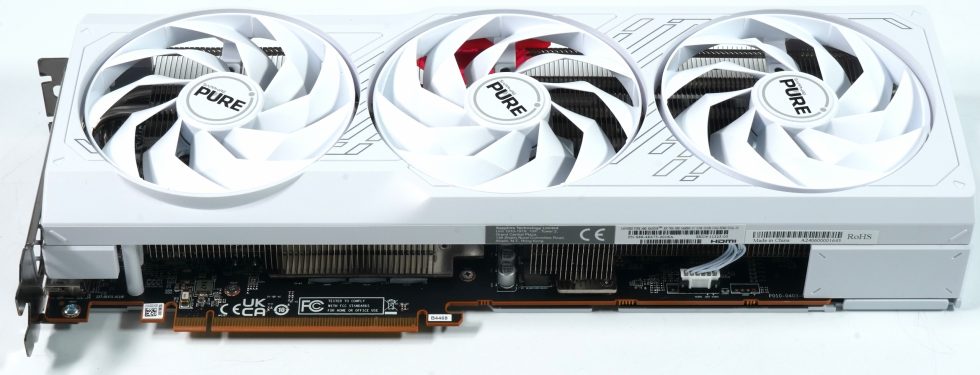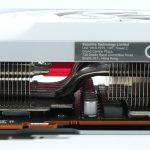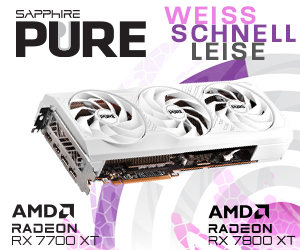Sapphire had already launched a white Radeon RX 7900GRE Pure 16GB shortly after the launch of the GRE in Germany, which I will test again today. Now that availability, prices and drivers have stabilized somewhat, today’s test was practically a must. Firstly, this GRE card lacks the drinker gene, as was the case with the Nitro, and secondly, it is so beautifully white and therefore fits in with the white builds that are currently in vogue. So let’s reset the power meter to zero and start again. And yes, it was also the wish of many readers to not just leave the overpowered card alone in the room, but to look for alternatives,
That’s exactly why I’m taking enough time today to look at the technical details and examine the implementation of the Pure in more detail, because Sapphire has delivered an excellent and surprisingly lightweight cooler that is also extremely quiet, despite the waste heat it generates. Of course, I also tested the whole thing, but left out a few nuances such as the extreme OC, because then we quickly revert to the old and not so fine drinking behavior. And nobody wants that. The price is now constant and well below 600 euros and only around 17 euros above the black Sapphire Radeon RX 7900GRE Pulse.
The Sapphire Radeon RX 7900 GRE Pulse 16 GB
The card has 80 CUs (four less than the XT) and 16 GByte GDDR6 (also four less than the XT). Everything is connected to a 256-bit interface (instead of 320 for the XT). This means that the card only has a maximum bandwidth of 576 GB/s with the additionally slowed-down VRAM and is therefore significantly lower than the RX 7800XT. The level 3 (Infinity) cache logically shrinks to 64 MB and is therefore the same size as the cache on the RX 7800XT. The total power consumption of 260 watts (TBP) claimed by AMD as a “reference” is somewhat met by the Pure; in gaming, between 255 and 270 watts are quite realistic, depending on the resolution and game.
The card looks timeless and pleasant, especially as the proportions are also right again. With a length of 32.2 cm from the outer edge of the slot bracket to the opposite end of the cooler cover, the card is also slightly longer than usual. The height of the inserted card is also slightly higher at 12 cm from the top edge of the PCIe slot to the top edge of the radiator cover. The installation depth of 4.7 cm plus 0.7 cm for the backplate is in line with a standard 2.5-slot design. Well, we know that, but the weight of 1118 grams is really bearable for this size.
On the top side we primarily see the two 8-pin (6 2) sockets for the external power supply. We don’t have to discuss any bending radii for the power supply connections with AMD this time either, everything is still really nice and old school. The LED-illuminated Radeon lettering is not missing this time either and Sapphire has also immortalized itself as a company with its logo. Well, the card is a little more expensive than the Pulse, but the innocent white on the paint and plastic makes up for the monetary pain. Sapphire doesn’t use a dual BIOS this time, but it’s not that bad.
If you turn the card backwards, you’ll see a massive backplate like the XTX and XT, but the ARGB header and BIOS switch are missing. The LED switch for manual eclipse is new.
With the two familiar DisplayPort 2.1 connections and an HDMI 2.1 socket, we have finished our navel-gazing of the Sapphire RX 7900 GRE Pure 16GB. Once again, the customer has to do without a real USB Type C port, as with the larger cards.
Overview of the RDNA3 cards – technical data
The RDNA3 cards are quite different, and not just on the outside. The card from Sapphire is similar to the reference card and is more of a real rational card. Inflated OC candidates are hardly faster overall, just significantly thirstier. We will see later that the concept has also worked.
Once again the tabular comparison:
| Radeon RX 7900 XTX |
Radeon RX 7900 XT |
Radeon RX 7900 GRE |
Radeon RX 7800 XT |
Radeon RX 7700 XT |
Radeon RX 7600 |
|
|---|---|---|---|---|---|---|
| Architecture | RDNA 3 | RDNA 3 | RDNA 3 | RDNA 3 | RDNA 3 | RDNA 3 |
| Chip Name | Navi 31 XTX | Navi 31 XT | Navi 31 XL | Navi 32 XT | Navi 32 XL | Navi 33 XL |
| GPU Design | Multi-Chiplet | Multi-Chiplet | Multi-Chiplet | Multi-Chiplet | Multi-Chiplet | Monolith |
| Process Node | TSMC N5 TSMC N6 |
TSMC N5 TSMC N6 |
TSMC N5 TSMC N6 |
TSMC N5 TSMC N6 |
TSMC N5 TSMC N6 |
TSMC N6 |
| Compute Units | 96 | 84 | 80 | 60 | 54 | 32 |
| Shader units | 6.144 | 5.376 | 5.120 | 3.840 | 3.456 | 2.048 |
| RT Accelerators |
96 | 84 | 80 | 60 | 54 | 32 |
| AI Accelerators | 192 | 158 | 160 | 120 | 108 | 64 |
| Memory | 24GB GDDR6 20 GT/s |
20 GB GDDR6 20 GT/s |
16GB GDDR6 18 GT/s |
16GB GDDR6 19.5 GT/s |
12GB GDDR6 18 GT/s |
8GB GDDR6 18 GT/s |
| Interface | 384 bit | 320 bit | 256 bits | 256 bits | 192-bit | 128 bits |
| TBP | 355 W | 315 W | 260 W | 263 W | 245 W | 165 W |
| MSRP | 999 USD | 899 USD | 599 USD | 499 USD | 449 USD | 269 USD |
Sapphire Radeon RX 7900 GRE Pure, 16GB GDDR6, 2x HDMI, 2x DP, lite retail (11325-03-20G / 11325-03-21G)
 | Zentrallager: 5 Stück lagernd, Lieferung 1-3 WerktageFiliale Wilhelmshaven: 5 Stück lagerndStand: 30.04.24 02:42 | 582,99 €*Stand: 30.04.24 02:47 |
 | Sofort verfügbar, Lieferzeit max. 1-3 Werktage | 583,00 €*Stand: 30.04.24 02:34 |
 | Sofort lieferbar, Lieferzeit max. 1-3 Werktage | 589,95 €*Stand: 30.04.24 02:40 |
Sapphire Pulse Radeon RX 7900 GRE, 16GB GDDR6, 2x HDMI, 2x DP, lite retail (11325-04-20G / 11325-04-21G)
 | Zentrallager: 5 Stück lagernd, Lieferung 1-3 WerktageFiliale Wilhelmshaven: 5 Stück lagerndStand: 30.04.24 02:42 | 575,99 €*Stand: 30.04.24 02:47 |
 | lagernd, Lieferzeit 1-2 Werktage | 576,00 €*Stand: 21.03.24 11:19 |
 | Lieferzeit 5-7 Werktage | 579,99 €*Stand: 30.04.24 02:40 |
Sapphire Pulse Radeon RX 7900 GRE, 16GB GDDR6, 2x HDMI, 2x DP, lite retail (11325-04-20G / 11325-04-21G)
 | Zentrallager: 5 Stück lagernd, Lieferung 1-3 WerktageFiliale Wilhelmshaven: 5 Stück lagerndStand: 30.04.24 02:42 | 575,99 €*Stand: 30.04.24 02:47 |
 | lagernd, Lieferzeit 1-2 Werktage | 576,00 €*Stand: 21.03.24 11:19 |
 | Lieferzeit 5-7 Werktage | 579,99 €*Stand: 30.04.24 02:40 |
- 1 - Introduction, technical data and technology
- 2 - Test setup and methods
- 3 - Teardown: PCB and components
- 4 - Teardown: cooler and backplate
- 5 - Teardown: material analysis
- 6 - Gaming performance Full-HD (1920 x 1080)
- 7 - Gaming performance WQHD (2560 x 1440)
- 8 - Gaming performance Ultra-HD (3840 x 2160)
- 9 - Gaming performance DLSS / FSR (3840 x 2160)
- 10 - Power consumption, transients and PSU recommendation
- 11 - Tmepratures, clock rates and infrared
- 12 - fan speed, noise and audio-sample
- 13 - Summary and conclusion


















































50 Antworten
Kommentar
Lade neue Kommentare
Veteran
1
Urgestein
Mitglied
Urgestein
Urgestein
Urgestein
Urgestein
Urgestein
Urgestein
Urgestein
Urgestein
Urgestein
Urgestein
Urgestein
Urgestein
1
Urgestein
Urgestein
Alle Kommentare lesen unter igor´sLAB Community →